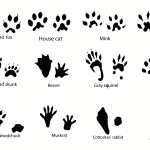- The Trackers!
- The Tracks
- The Trackers Making Tracks.
 The DOC had great weather for a great day. It was warm but not so warm that the snow melted. Consequently, we got to learn about and identify a number of different animal tracks.
The DOC had great weather for a great day. It was warm but not so warm that the snow melted. Consequently, we got to learn about and identify a number of different animal tracks.
Prior to our start a hunter warned us to keep an eye out for a mother bear with two cubs. Apparently, momma bear was not happy with him and approached him earlier in the week. We found no bear tracks, but then we did make a lot of noise as we sang Jingle Bells while climbing the mountain.
We did see a lot of tracks: turkey, fox, deer, squirrel, raccoon, and voles ( We scooped the snow off the top of the vole tunnels to see their tracks.). We also saw a number of tracking clues such as scats , digs, debarking, trails, and hair. The debarking was more likely caused by a porcupine since it was high up in the tree, higher than if a rabbit had done it. The deer hair and snow markings were indicative of a hunter who was dragging out his or her kill.
Three out of the four basic animal tracking gaits were observed: Straight Walker, Hopper, and Waddler. We did not see any Bounders. Straight Walker is the most common gait for felines (house cats, bobcats), canines (dog, coyote, fox), and ungulates (deer, cow, sheep, moose). Hopping is the gait used by cottontail rabbits, snowshoe hares, squirrels, chipmunks, mice, meadow voles and shrews. Waddlers are mostly heavy-set mammals such as beavers, porcupines, muskrat , raccoons, skunks, opossum, and bear. Bounding is the common gait for most of the weasel family -short and long haired weasel, mink, otter, marten, and fisher. We analyzed a squirrel track noting that the Hopper track will have the front feet in the back and the back feet in the front of the track. We also discussed how some animals register when they walk (back foot fits into front print) a pattern most common in predators.
Other tracking identification information included the number of toes on the front and back feet of an animal and whether or not claw marks are present. Canines, felines, and rabbits have 4 toes on both front and back feet. All but felines have claw prints. Bears, raccoons and opossums have 5 toes front and back with claws marks. Shrew/moles, squirrels/beavers/woodchucks, rats/mice/voles, and porcupines have 4 toes on the front feet and 5 on the back with claw marks evident. Deer, elk, and moose have 2 hooves in the front and 2 hooves in the back with no claws.
Now that you know so much about tracking go outside on a hike and give it a try!

